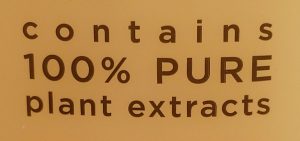There are laws about what manufacturers say on their labels – they cannot lie. They can, however, format the truth in a way that leads you to think it says something else. Sort of “marketing truth.”
Prime example, my body wash. I’m not complaining about the body wash. I’m not even complaining about what the label says versus what they want me to think the label says. I’m not complaining at all. I am observing great marketing in action.
The Lie You Think is the Truth

Part of why lawyers hide things is the small print is that the human brain reads the big print first and may – or may not – get to the small print last.
In the image above “100% PURE” is the big print. Next, “plant extracts” is in slightly smaller font and in lower-case letters. Finally, we have “contains” – the first line. This line is in lower case letters, maybe an even smaller font, AND the letters have much more space between them. Graphically, this spacing keeps everything flush; mentally, this is another trick to reduce the impact of the word on a person’s brain. What that all sums up to is that while the text says, “contains 100% pure plant extracts,” what your brain takes in is, “100% pure plant extracts … contains.”
The lie is: This product is 100% pure plant extracts.
What the label does not say includes:
- Every ingredient is a 100% pure plant extract
- Every ingredient is 100% pure
- Every ingredient is a plant extract
- Of the plant extracts, all of them are pure
Nope, what the label says is that somewhere in the ingredient list is at least one plant extract that is 100% pure.
BIG DIFFERENCE
The Truth of the Lie
Isn’t it amazing what the word “contain” can do?
According to my friend dictionary.com, the first definition of contain is, “to hold or include within its volume or area.”
Just because item A is holding item B, doesn’t mean that item A isn’t holding something else as well. I regularly put ice and lemon in my water bottle, thus my water bottle is not 100% full of any one thing. Instead, it contains water, ice, and lemon.
Without reading the actual ingredient list, we don’t know:
- What plant extracts the body wash contains
- How much of the actual product falls under the category of “plant extract”
- How many of those plant extracts are actually 100% pure (rather than just 43% pure)
SIDE NOTE: How does a person impurify a plant extract? Couldn’t the manufacturer just list the impurities as separate ingredients?
Marketing is Fun
Understanding some basics of the human brain means the difference between telling the truth and saying something true that people interpret more favorably.
There’s a reason there are advanced degrees in this stuff.
– Lorrie Nicoles
